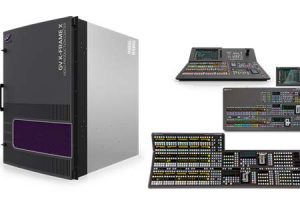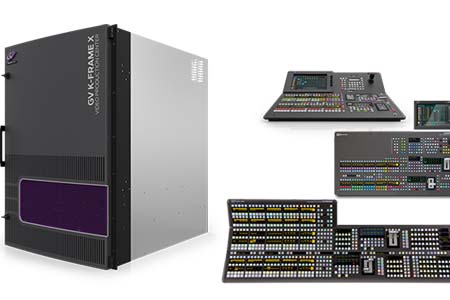New GV K-Frame X eases the IP transition with support for any combination of SDI and IP inputs and 9 M/Es.
 The new GV K-Frame X Video Processing Engine from Grass Valley builds upon the power, performance and flexibility of the current K-Frame, the company claims, by providing customers the added versatility of all SDI, all IP, or mixed SDI and IP board configurations, with no loss of I/O density or production creativity when switching between these formats. The company introduced the GV K-Frame X this week at the annual SVG Summit in New York City.
The new GV K-Frame X Video Processing Engine from Grass Valley builds upon the power, performance and flexibility of the current K-Frame, the company claims, by providing customers the added versatility of all SDI, all IP, or mixed SDI and IP board configurations, with no loss of I/O density or production creativity when switching between these formats. The company introduced the GV K-Frame X this week at the annual SVG Summit in New York City.
A solution with GV K-Frame Xs level of capability and flexibility reportedly addresses the need for both IP and SDI signal sources in a high-end performance processing engine. Customers can now reap the benefits, the company claims, of unlimited flexibility between SDI and IP sources while leveraging the enormous creativity afforded by 9 M/Es.
The new frame, which boasts both compressed via TICO and uncompressed 4K along with HDR support, continues Grass Valleys any frame, any panel tradition. Customers can choose from any of the Kayenne, Karrera or GV Korona control surfaces, ensuring that any show created on any K-Frame or panel will work seamlessly on the new GV K-Frame X. Additionally, this backwards compatibility also applies to existing K-Frame Mix/Effect boards reportedly easing the burden of managing inventory for spares and replacements.
GV K-Frame X allows broadcasters to move into the IP environment without totally disrupting their creative production processes or their teams, as it requires little to no additional equipment training, said Greg Huttie, vice president of switchers, Grass Valley. Not only can the X be used with any Grass Valley switcher panel, customers can also leverage our trademark platform-wide convenienceany shows created on any K-Frame switcher can be saved and shared among other switchers to maintain a broadcasters look and feel.
The GV K-Frame X is the next step in support of evolving IP and UHD workflows worldwide. Grass Valley will begin shipping the new systems in December with a full manufacturing release scheduled for February 2018.
















































































